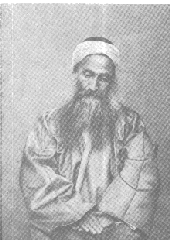Subh-i-Azal
| Subh-i-Azal | |
|---|---|

Mírzá Yaḥyá Núrí, Ṣubḥ-i-Azal, photo by Captain Arthur Young, end 1889-beginning 1890, published by Edward G. Browne in his translation of Tarikh-I-Jadid.
|
|
| Born |
Mírzá Yahya Núrí 1831 Tehran, Persia (present-day Iran) |
| Died |
April 29, 1912 (aged 81) (In the lunar calendar he would have been about 82-3.) Famagusta , Ottoman Empire (present-day Cyprus) |
| Known for | Founder of Azali Babism |
| Successor | `Yahya Dawlatul-Badi` |
Ṣubḥ-i-Azal (Morning of Eternity) (1831–1912, born Mírzá Yaḥyá Núrí) was a Persian religious leader of Azali Bábism.
Mirza Yahya was born in 1831 to Kuchak Khanum-i-Karmanshahi (Ruhi, A Brief Biography) and Mírzá Buzurg-i-Núrí, in the province of Mazandaran, and a younger-half-brother of Mírzá Husayn `Ali, better known as Bahá'u'lláh. His mother died while giving birth to him, and his father died in 1834 when Mirza Yahya was three years old. His father is buried at Vadi-al-Islam in Najaf. Mirza Yahya was committed to the care of his stepmother Khadíjih Khánum, the mother of Bahá'u'lláh. In 1844, at about the age of 14, he became a follower of the Báb.
Shortly before the Báb's execution, a follower of the Báb, Abd al-Karim, brought to the Báb's attention the necessity to appoint a successor; thus the Báb wrote a certain number of tablets which he gave to Abd al-Karim to deliver to Subh-i-Azal and Bahá'u'lláh. These tablets were later interpreted by both Azalis and Bahá'ís as proof of the Báb's delegation of leadership. Some sources state that the Báb did this at the suggestion of Bahá'u'lláh.
In one of the tablets, which is commonly referred to as the Will and Testament of the Báb, Subh-i-Azal is viewed to have been appointed as leader of the Bábis after the death of the movement's founder; the tablet, in verse 27, also appears to order Subh-i-Azal "...to obey Him Whom God Shall Make Manifest." Some state that Subh-i-Azal's claim to successorship is obvious; others state that the Báb, for the purposes of secrecy, when corresponding with Bahá'u'lláh would address the letters to Subh-i-Azal. After the Báb's death Subh-i-Azal came to be regarded as the central authority in the movement.
Subh-i-Azal's leadership was controversial. He generally absented himself from the Bábí community spending his time in Baghdad in hiding and disguise; and even went so far as to publicly disavow allegiance to the Báb on several occasions. Subh-i-Azal gradually alienated himself from a large proportion of the Bábís who started to give their alliance to other claimants. Manuchehri states that Subh-i-Azal remained in hiding because he was primarily concerned with personal safety, due a statement from the Báb in his will and testament that Subh-i-Azal should protect himself.
During the time that both Bahá'u'lláh and Subh-i-Azal were in Baghdad, Bahá'u'lláh publicly and in his letters pointed to Subh-i-Azal as the leader of the community. However, since Subh-i-Azal remained in hiding, Bahá'u'lláh performed much of the daily administration of the Bábí affairs. Then, in 1863 Bahá'u'lláh made a claim to be Him Whom God Shall Make Manifest, the messianic figure in the Báb's writings, to a small number of followers, and in 1866 he made the claim public. Bahá'u'lláh's claims threatened Subh-i-Azal's position as leader of the religion since it would mean little to be leader of the Bábís if "Him Whom God Shall Make Manifest" were to appear and start a new religion. Subhh-i-Azal responded by making his own claims, but his attempt to preserve the traditional Bábísm was largely unpopular, and his followers became the minority.
...
Wikipedia
